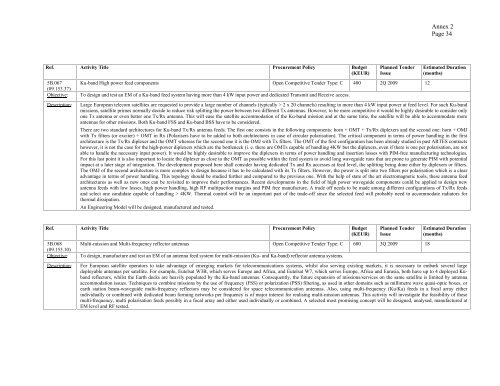ARTES-5.1 â ESA Telecom Technology Workplan ... - Emits - ESA
ARTES-5.1 â ESA Telecom Technology Workplan ... - Emits - ESA
ARTES-5.1 â ESA Telecom Technology Workplan ... - Emits - ESA
- No tags were found...
Create successful ePaper yourself
Turn your PDF publications into a flip-book with our unique Google optimized e-Paper software.
Annex 2Page 34Ref. Activity Title Procurement Policy Budget(KEUR)5B.067(09.153.37)Objective:Description:Planned TenderIssueKu-band High power feed components Open Competitive Tender Type: C 400 2Q 2009 12To design and test an EM of a Ku-band feed system having more than 4 kW input power and dedicated Transmit and Receive access.Estimated Duration(months)Large European telecom satellites are requested to provide a large number of channels (typically > 2 x 20 channels) resulting in more than 4 kW input power at feed level. For such Ku-bandmissions, satellite primes normally decide to reduce risk splitting the power between two different Tx antennas. However, to be more competitive it would be highly desirable to consider onlyone Tx antenna or even better one Tx/Rx antenna. This will ease the satellite accommodation of the Ku-band mission and at the same time, the satellite will be able to accommodate moreantennas for other missions. Both Ku-band FSS and Ku-band BSS have to be considered.There are two standard architectures for Ku-band Tx/Rx antenna feeds. The first one consists in the following components: horn + OMT + Tx/Rx diplexers and the second one: horn + OMJwith Tx filters (or exciter) + OMT in Rx (Polarisers have to be added to both architectures in case of circular polarisation). The critical component in terms of power handling in the firstarchitecture is the Tx/Rx diplexer and the OMT whereas for the second one it is the OMJ with Tx filters. The OMT of the first configuration has been already studied in past <strong>ARTES</strong> contractshowever, it is not the case for the high-power diplexers which are the bottleneck (i. e. there are OMTs capable of handling 4KW but the diplexers, even if there is one per polarisation, are notable to handle the necessary input power). It would be highly desirable to improve the diplexers in terms of power handling and insertion losses with PIM-free manufacturing technologies.For this last point it is also important to locate the diplexer as close to the OMT as possible within the feed system to avoid long waveguide runs that are prone to generate PIM with potentialimpact at a later stage of integration. The development proposed here shall consider having dedicated Tx and Rx accesses at feed level, the splitting being done either by diplexers or filters.The OMJ of the second architecture is more complex to design because it has to be calculated with its Tx filters. However, the power is split into two filters per polarisation which is a clearadvantage in terms of power handling. This topology should be studied further and compared to the previous one. With the help of state of the art electromagnetic tools, these antenna feedarchitectures as well as new ones can be revisited to improve their performances. Recent developments in the field of high power waveguide components could be applied to design newantenna feeds with low losses, high power handling, high RF multipaction margins and PIM free manufacture. A trade off needs to be made among different configurations of Tx/Rx feedsand select one candidate capable of handling > 4KW. Thermal control will be an important part of the trade-off since the selected feed will probably need to accommodate radiators forthermal dissipation.An Engineering Model will be designed, manufactured and tested.Ref. Activity Title Procurement Policy Budget(KEUR)5B.068(09.153.10)Objective:Description:Planned TenderIssueMulti-mission and Multi-frequency reflector antennas Open Competitive Tender Type: C 600 3Q 2009 18To design, manufacture and test an EM of an antenna feed system for multi-mission (Ku- and Ka-band) reflector antenna systems.Estimated Duration(months)For European satellite operators to take advantage of emerging markets for telecommunications systems, whilst also serving existing markets, it is necessary to embark several largedeployable antennas per satellite. For example, Eutelsat W3B, which serves Europe and Africa, and Eutelsat W7, which serves Europe, Africa and Eurasia, both have up to 4 deployed Kubandreflectors, whilst the Earth decks are heavily populated by the Ka-band antennas. Consequently, the future expansion of missions/services on the same satellite is limited by antennaaccommodation issues. Techniques to combine missions by the use of frequency (FSS) or polarization (PSS) filtering, as used in other domains such as millimetre wave quasi-optic boxes, orearth station beam-waveguide multi-frequency reflectors may be considered for space telecommunication antennas. Also, using multi-frequency (Ku/Ka) feeds in a focal array eitherindividually or combined with dedicated beam forming networks per frequency is of major interest for realising multi-mission antennas. This activity will investigate the feasibility of thesemulti-frequency, multi polarisation feeds possibly in a focal array and either used individually or combined. A selected most promising concept will be designed, analysed, manufactured atEM level and RF tested.
















